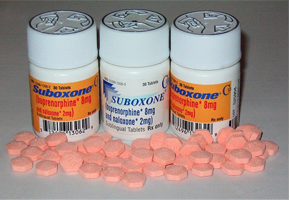Many people describe opiate withdrawal as one of the worst types of withdrawal you can go through. Although opiate withdrawal is not deadly, it is extremely unpleasant. There are several drugs on the market that help with opiate withdrawal. If you use opiates, you have probably heard of Suboxone. Suboxone is an opiate replacement drug with an opiate blocker built in. Many doctors prescribe Suboxone for opiate addiction to help people stop the addiction without the unpleasant side effects of opiate withdrawal.
What is Suboxone made out of?

Suboxone is made from Buprenorphine and Naloxone.
According to Reckitt Benckiser Healthcare, the manufacturer of Suboxone, it is made from buprenorphine and Naloxone as well as a variety of inactive binding agents. These two chemicals combine to make it effective at stopping opiate addiction and preventing opiate withdrawal.
- Buprenorphine an opioid agonist replaces the opiates at the receptor sites that opiates bind to. When it does this, it not only stops the withdrawal symptoms it also stops the opiates so a person does not absorb them and slide further into addiction.
- Naloxone an opiate antagonist blocks opiates from binding to the receptor sites and reverses the opiates effects. Many healthcare workers use Naloxone in the form of Narcan to stop opiate overdose. It instantly stops the overdose and sends the person straight into withdrawal.
These two drugs work together to prevent cravings, block opiates, and stop a person from using again. They are more effective at stopping opiate addiction together than either one is alone.
What are the Side Effects of Suboxone?
Many of the side effects of Suboxone resemble the flu, according to the Food and Drug Administration. These side effects are rarely bothersome and usually do not stop people from taking it. Some of these side effects are:
- nausea,
- vomiting,
- sleep disturbances,
- excessive sweating,
- mood swings, and
- runny nose.
There are also warnings that Suboxone is mildly addictive but not as bad as the drugs that it replaces. Most users prefer Suboxone to going into opiate or opioid withdrawal. Many long term users say that they experience little to no withdrawal when taking it.
Some researchers state that there is some danger to those who decide to use opiates while on Suboxone or while the drug is still in their system. It can cause serious interaction issues with some drugs that are similar to it.
How is Suboxone Prescribed?
Suboxine is prescribed in sublingual or tablet form. The sublingual Suboxone is the most common because it is the easiest to titrate the dose with. A doctor will evaluate you based on:
- your height,
- your weight,
- how much of the opiate you used in the past,
- which opiate it was, painkillers, heroin, methadone, morphine, or a less common one,
- how long you took the opiate for,
- how often you used the opiate,
- how much of the opiate you used daily,
- your risk of overdose, and
- whether you are likely to relapse.
These are all factors in the decision to both use Suboxone and how much Suboxone to use. Once they calculate the initial dose, you will take it and see the doctor again in approximately 24 hours. Some doctors may prescribe Suboxone to go home with you but usually not until you are on a steady dose. Doctors raise and lower the dose depending on your symptoms. This process is called titration.
Who Takes Suboxone?
Anyone with an opiate addiction can take Suboxone but there are a few people in particular that are good candidates for Suboxone treatment. These are:
- people who have tried other methods to quit an opiate,
- people who do not have any other addictions,
- someone who is prone to overdose,
- someone who has a history of taking more medication than is prescribed, and
- anyone who wants to get off opiates.
Many people who take methadone switch to Suboxone because of the dangers and side effects that methadone has. This is not to say that if you do not meet these criteria you cannot try Suboxone treatment for opiate addiction. Many doctors are turning to Suboxone as an alternative to many other treatments on the market today.
How Long Suboxone in the Body?
Although the primary How long Suboxone stays in the body depends on several factors. These factors are:
- how long you have been taking Suboxone,
- how much Suboxone you take at a time,
- if you take more Suboxone than prescribed,
- your body weight,
- your overall health,
- your activity level, and
- how often you take Suboxone, and
- your overall metabolism.
On average Suboxone stays active in your body anywhere from one to three days or 20 to 70 hours. This means that the drug is still working in your system during this time. It stays actually stays much longer than that. It can be detected for around 10 days after your last dose.
This time is under optimal conditions. Buprenorphine is detectable in urine for around four days after the last dose is taken. This means that if someone tests for it in blood or urine it will test positive. In a drug test, it shows up as an opiate because it contains buprenorphine.
Suboxone is a very powerful drug that treats opiate addiction. Many people use Suboxone for this purpose. If you have more questions about Suboxone, call us at 888-646-0865 (Who Answers?) . We are happy to provide any information you might need.